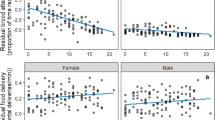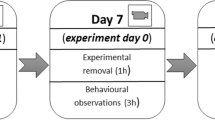Abstract
Emlen and Oring (1977) suggested that monogamy in birds is maintained because of the need for strict biparental care. A corollary of their suggestion is that paternal care should decrease under conditions of high food abundance. An alternative is that paternal care would increase if males take advantage of the higher food abundance by trying to reduce the length of the nestling feeding period. We tested these two ideas using yellow warblers (Dendroica petechia) by providing some pairs with supplemental food, thereby reducing the importance of biparental care. However, the extra food did not decrease paternal effort, nor did it increase it (Fig. 2). Early in the nestling period experimental females brooded more but visited their nestlings less than did control females, but later, when brooding times decreased, experimental females fed their nestlings more than did control females (Fig. 3). There were no significant differences in nestling survival (Fig. 5), but nestlings in the control treatment were larger and heavier up to 6 days old (Fig. 6). The main effect of supplemental food was on maternal, not paternal behaviour. Models of biparental care assume interdependence between the parental effort of both parents. In this species, however, males and females provide for their brood independently from each other.
Similar content being viewed by others
References
Bart J, Tornes A (1989) Importance of monogamous male birds in determining reproductive success. Behav Ecol Sociobiol 24: 109–116.
Biermann GC, Sealy SG (1982) Parental feeding of nestling yellow warblers in relation to brood size and prey availability. Auk 99: 332–341.
Björklund M, Westman B (1986) Adaptive advantages of monogamy in the great tit (Parus major): an experimental test of the polygyny threshold model. Anim Behav 34: 1436–1440.
Carey M (1990) Effects of brood size and nestling age on parental care by male field sparrows (Spizella pusilla). Auk 107: 580–586.
Chase I (1980) Cooperative and noncooperative behavior in animals. Am Nat 115: 827–857.
Duckworth JW (1992) Effects of mate removal on the behaviour and reproductive success of reed warblers Acrocephalus scirpaceus. Am Nat 134: 164–170.
Dunn PO, Hannon SJ (1992) Effects of food abundance and male parental care on reproductive success and monogamy in tree swallows. Auk 109: 488–499.
Dunn PO, Robertson RJ (1992) Geographic variation in the importance of male parental care and mating systems in tree swallows. Behav Ecol 3: 291–299.
Emlen ST, Oring LW (1977) Ecology, sexual selection, and the evolution of mating systems. Science 97: 215–223.
Gowaty PA (1983) Male parental care and apparent monogamy among eastern bluebirds (Sialia sialis). Am Nat 121: 149–157.
Greenlaw JS, Post W (1985) Evolution of monogamy in seaside sparrows, Ammodramus maritimus: test of hypotheses. Anim Behav 33: 373–383.
Grundel R (1987) Determinants of nestling feeding rates and parental investment in the mountain chickadee. Condor 89: 319–328.
Henderson BS (1975) Role of chick's begging behavior in the regulation of parental feeding behavior of Larus glaucescens. Condor 77: 488–492.
Hipes DL, Hepp GR (1993) Effect of mate removal on nest success of female wood ducks. Condor 95: 220–222.
Houston AI, Davies NB (1985) The evolution of cooperation and life history in dunnocks Prunella modularis. In Sibley R, Smith RH (eds) Behavioural ecology: the ecological consequences of adaptive behaviour. Blackwell, Oxford, pp 471–487.
Johnson LS, Merkle MS, Kermott LH (1992) Experimental evidence for importance of male parental care in monogamous house wrens. Auk 109: 662–664.
Lack D (1968) Ecological adaptations for breeding in birds. Methuen, London.
LaTour SA, Miniard PW (1983) The use and misuse of repeated measures analysis in marketing research. J Market Res 20: 45–57.
Lozano GA, Lemon RE (in press) Male plumage, paternal care and reproductive success in yellow warblers (Dendroica petechia). Anim Behav.
Lyon BE, Montgomerie RD, Hamilton LD (1987) Male parental care and monogamy in snow buntings. Behav Ecol Sociobiol 20: 377–382.
Martin K, Cooke F (1987) Bi-parental care in willow ptarmigan: a luxury? Anim Behav 35: 369–379.
Meek SB, Robertson RJ (1994) Effects of male removal on the behaviour and reproductive success of female eastern bluebirds Sialia sialis. Anim Behav 136: 305–312.
Pierotti R (1981) Male and female parental roles in the western gull under different environmental conditions. Auk 98: 532–549.
Potvin C, Lechowicz MJ, Tardif S (1990) The statistical analysis of ecophysiological response curves obtained from experiments involving repeated measures. Ecology 71: 1389–1400.
Sasvári L (1986) Reproductive effort of widowed birds. J Anim Ecol 55: 553–564.
Sasvári L (1990) Feeding response of mated and widowed bird parents to fledglings: an experimental study. Ornis Scand 21: 287–292.
Smith JNM, Yom-Tov Y, Moses R (1982) Polygyny, male parental care, and sex ratio in song sparrows: an experimental study. Auk 99: 555–564.
Weatherhead PJ (1979) Ecological correlates of monogamy in tundra-breeding savannah sparrows. Auk 96: 391–401.
Whillans KV, Falls JB (1990) Effects of male removal on parental care of female white-throated sparrows, Zonotrichia albicollis. Anim Behav 39: 869–878.
Whittingham LA, Robertson RJ (1993) Nestling hunger and parental care in red-winged blackbirds. Auk 110: 240–246.
Winer BJ (1971) Statistical principles in experimental design, 2nd ed. McGraw Hill, New York.
Wittenberger JF (1982) Factors affecting how male and female bobolinks apportion parental investment. Condor 84: 22–39.
Wolf L, Ketterson ED, Nolan V Jr (1988) Paternal influence on growth and survival of dark-eyed junco young: do parental males benefit? Anim Behav 36: 1601–1618.
Wright J, Cuthill I (1989) Manipulation of sex differences in parental care. Behav Ecol Sociobiol 25: 171–181.
Wright J, Cuthill I (1990) Biparental care: short-term manipulation of partner contribution and brood size in the starling, Sturnus vulgaris. Behav Ecol 1: 116–124.
Author information
Authors and Affiliations
Additional information
Communicated by M. A. Elgar
Rights and permissions
About this article
Cite this article
Lozano, G.A., Lemon, R.E. Food abundance and parental care in yellow warblers (Dendroica petechia). Behav Ecol Sociobiol 37, 45–50 (1995). https://doi.org/10.1007/BF00173898
Received:
Accepted:
Issue Date:
DOI: https://doi.org/10.1007/BF00173898




